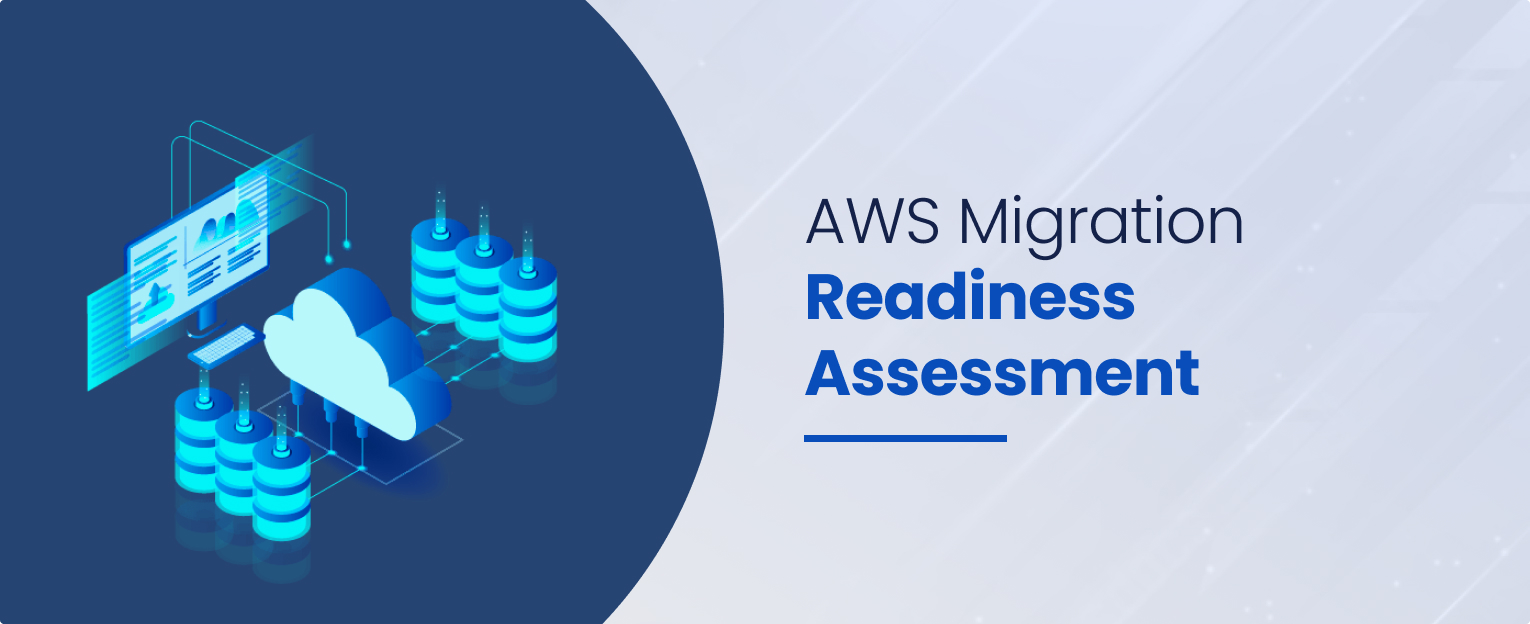Whether you are a small startup or a large enterprise, it is vital to understand the intricacies of AWS migration readiness. It is important to optimize systems’ performance, reduce downtime, and maximize the benefits of AWS cloud for your organization.
Let’s explore the key components of an AWS Migration Readiness Assessment and how it empowers organizations to make well-informed decisions before embarking on their cloud journey.
In this article, we will cover everything from evaluating technical readiness to assessing business impact and security measures so that you can easily handle potential challenges and identify opportunities during the migration process.
What is AWS Migration Readiness Assessment?
AWS Migration Readiness Assessment is a systematic and comprehensive evaluation process that organizations undertake before migrating their existing IT infrastructure and applications to Amazon Web Services (AWS) cloud platform.
It involves assessing various aspects of the organization, including technical, operational, financial, security, and business readiness, to determine the feasibility, risks, and potential benefits of the migration.
Primarily, the cloud readiness assessment for AWS aims to provide a clear understanding of the organization’s current state and identify any gaps or challenges that may hinder a successful migration. This enables organizations to create a well-defined roadmap for a smooth transition to AWS.
The AWS Migration Readiness Assessment is a critical process that requires alignment and collaboration among all relevant stakeholders, including those providing cloud migration consulting services.
The migration to AWS can have far-reaching and lasting impacts on both the business and the organization as a whole. Hence, it becomes imperative for all key parties involved to be on the same page and work together to ensure a successful migration.
The transition to AWS requires considerations that extend beyond the technical scope, influencing the business and the organization holistically.
As such, Cloud Migration Consulting services come to the forefront as indispensable partners in orchestrating a smooth and successful migration. Their expertise not only ensures technical readiness but also helps in aligning migration strategies with overarching business goals and objectives.
Purpose of AWS Migration Readiness Assessment
The primary purpose of the AWS Migration Readiness Assessment is to lay the groundwork for a successful migration to AWS while minimizing potential risks. It serves several key objectives:
- Risk Identification and Mitigation: The AWS assessment helps identify and understand the potential risks associated with migrating to AWS. By recognizing potential challenges early on, organizations can take proactive steps to mitigate these risks and ensure a smoother migration process.
- Cost Estimation and Optimization: Migration to the cloud involves various expenses, such as infrastructure setup, data transfer, and ongoing usage costs. Knowing the anticipated costs of the migration enables organizations to plan their budget effectively. They can set aside adequate funds for the migration project and allocate resources to ensure a smooth transition.
- Readiness Evaluation: The assessment also evaluates the organization’s technical operational, and security capabilities. This evaluation ensures that the organization is adequately prepared for the migration and can address any gaps or deficiencies before proceeding.
- Business Alignment: The cloud readiness assessment considers the organization’s business goals and objectives, and aligns them with the migration strategy. This ensures that the migration not only meets the technical requirements but also supports the broader business objectives and growth plans.
- Optimal Cloud Strategy: By understanding the organization’s existing infrastructure and applications, the assessment helps determine the most suitable migration strategy, such as a lift-and-shift approach, re-platforming, or re-architecting, to achieve the desired outcomes efficiently.
For a comprehensive look on cloud migration considerations, read our article on server-to-cloud transition.
Case Studies
Growth. Enabled.

Sunburst Type To Learn

InGenius Prep

Magento Cloud Migration

Nutrition Detection App
Importance of Assessing Migration Readiness
Assessing migration readiness is crucial for an organization that is considering moving its IT infrastructure and applications to a cloud platform like Amazon Web Services (AWS). The process involves a comprehensive evaluation of various aspects of the organization to determine its preparedness for the migration.
Here are some key reasons highlighting the significance of assessing migration readiness:
- Risk Avoidance: Migrating to the cloud involves various complexities and challenges. By conducting a thorough assessment, organizations can identify potential pitfalls and risks early on, which allows them to take proactive measures to avoid costly mistakes during the migration process.
- Cost Management: Migration readiness assessment provides a clear understanding of the cost implications of moving to AWS. This knowledge helps organizations allocate resources effectively, optimize their budget, and plan for any unforeseen expenses beforehand.
Here is our in-depth article to understand cloud migration costs.
- Efficiency and Performance: Evaluating technical and operational readiness before initiating the migration process ensures that the organization’s infrastructure and applications can function optimally in the cloud environment. This assessment helps improve efficiency, scalability, and performance, which maximizes the benefits of AWS services for the organization.
- Data Security and Compliance: The assessment evaluates the organization’s security measures and compliance requirements. This is critical to safeguard sensitive data, maintain regulatory compliance, and protect against potential security threats in the cloud.
- Alignment with Business Goals: By aligning migration objectives with broader business goals, the organization can drive digital transformation and leverage the cloud’s capabilities to gain a competitive advantage.
Preparing for the AWS Migration Readiness Assessment
Preparing for the AWS Migration Readiness Assessment involves getting ready for a comprehensive evaluation of your organization’s readiness to migrate to Amazon Web Services (AWS) cloud platform. It includes various essential steps such as:
- Identifying Stakeholders and Forming a Dedicated Team: The first step is to identify key stakeholders from different departments within the organization and form a dedicated migration team. These stakeholders bring diverse perspectives and expertise, ensuring that all aspects of the migration process are thoroughly evaluated.
- Defining Clear Migration Goals: Clearly outlining migration goals is critical to aligning the assessment with the organization’s vision. Establishing specific and measurable objectives helps focus the assessment on achieving desired outcomes and ensures that the migration aligns with the organization’s strategic priorities.
- Assessing Existing IT Infrastructure and Applications: A comprehensive evaluation of the organization’s current IT infrastructure and applications is crucial. Understanding the architecture, dependencies, and performance of the existing setup helps identify potential challenges and opportunities during the migration.
- Setting Realistic Timeline and Budget: Establishing a realistic timeline and budget for the assessment ensures that resources are allocated efficiently. Adequate planning allows the organization to engage AWS experts or partners, if necessary, and acquire necessary tools and services for a thorough evaluation.
- Collaborating with AWS Experts or Partners: Working with AWS experts or partners brings in-depth knowledge and best practices to the assessment process. Their expertise enhances the accuracy and effectiveness of the evaluation. This helps organizations to identify specific risks and tailor the migration strategy accordingly.
- Gathering Relevant Data, Analyzing Findings, and Documenting Results: During the assessment, relevant data is collected from various sources. Performance metrics, cost data, and security measures are analyzed to gain insights into the organization’s IT landscape. Clear documentation of the assessment findings ensures that key insights and recommendations are easily accessible for decision-making during the migration journey.
By thoroughly preparing for the AWS Migration Readiness Assessment, organizations can identify potential risks, address gaps, and make well-informed decisions, which ultimately ensures a successful migration to the AWS cloud platform.
Key Components of AWS Migration Readiness Assessment
The AWS Migration Readiness Assessment comprises several key components that collectively form a comprehensive evaluation of an organization’s readiness to migrate to Amazon Web Services (AWS) cloud platform.
These components help assess various aspects of the organization and provide valuable insights to facilitate a successful migration:
- Business Readiness Assessment: This component evaluates the organization’s overall readiness for migration from a business perspective. It involves understanding the organization’s goals, objectives, and long-term vision for the migration.
Assessing business readiness helps align migration strategies with the broader business objectives, ensuring that the migration contributes positively to the organization’s growth and success. - Technical Readiness Assessment: The technical component focuses on evaluating the existing IT infrastructure and applications. It aims to determine the compatibility of the organization’s applications with AWS services and assesses the level of complexity involved in migrating each application.
Understanding technical readiness allows the organization to plan for necessary changes and optimizations to ensure a smooth migration process. - Financial Readiness Assessment: This component focuses on estimating the cost of migration to AWS and identifying potential cost-saving opportunities. By understanding the financial implications of the migration, organizations can allocate resources effectively and optimize their budget.
The financial assessment also helps justify the return on investment (ROI) and demonstrate the value of migrating to AWS. - Operational Readiness Assessment: The operational component evaluates the readiness of the organization’s IT operations and support teams for the migration. It involves assessing the skills and knowledge of the personnel involved in the migration process and identifying any training needs.
A strong operational readiness ensures that the organization can efficiently manage the AWS environment and handle any post-migration challenges effectively. - Security Readiness Assessment: This component is focused on evaluating the organization’s security measures and protocols. It identifies potential security risks and vulnerabilities, ensuring that appropriate security controls are in place to protect sensitive data and comply with industry regulations during and after the migration.
By analyzing these key components of the AWS Migration Readiness Assessment, organizations gain a holistic understanding of their readiness for migration.

Ready to Unlock the full potential of Cloud Migration?
Schedule a free consultation with our experts and embark on a seamless journey to the cloud! Let us optimize your infrastructure, enhance security, and drive limitless growth with our state-of-the-art cloud migration services. Take the next step in your cloud-powered future.
Best Practices for AWS Readiness Assessment
It is critical to follow certain guidelines when conducting an AWS Migration Readiness Assessment. By following these best practices, organizations can improve their AWS readiness and ensure a successful and seamless migration process.
1. Analyzing the Assessment Results
Upon completing the AWS Migration Readiness Assessment, it is crucial to thoroughly analyze the results to gain valuable insights.
This involves carefully reviewing the data collected during the assessment process and evaluating the findings from each component, such as technical readiness, financial implications, and operational preparedness.
The analysis helps identify critical areas that impact the migration strategy and provides a clear understanding of the organization’s readiness to migrate to AWS.
2. Identifying Strengths and Weaknesses in Migration Readiness
During the analysis, organizations identify the strengths and weaknesses in their migration readiness specifically for AWS.
This includes recognizing areas where the organization excels, such as existing cloud-native applications or robust security measures.
Simultaneously, it reveals weaknesses, like applications requiring significant re-architecting or gaps in compliance with AWS best practices. Identifying strengths allows organizations to leverage existing advantages, while addressing weaknesses enables proactive measures to mitigate potential challenges during the migration.
3. Prioritizing Areas that Require Immediate Attention
By identifying critical weaknesses and challenges in the context of AWS migration, organizations can prioritize areas that need immediate attention.
This includes addressing issues that could significantly impact the migration timeline or pose potential risks to the success of the migration process.
Prioritization ensures that the most pressing concerns are addressed promptly, reducing potential disruptions and enhancing the efficiency of the migration.
4. Establishing a Risk Mitigation Plan
A comprehensive risk mitigation plan is essential to manage uncertainties and challenges related to the AWS migration. Based on the assessment results, organizations develop a structured plan to address identified risks effectively.
This plan outlines specific actions, responsibilities, and timelines for mitigating potential issues and ensuring a smooth migration journey.
5. Addressing Gaps and Enhancing Migration Readiness
The assessment reveals gaps in the organization’s readiness for AWS migration, such as insufficient cloud expertise or outdated application architectures.
Addressing these gaps involves implementing necessary changes, improvements, and optimizations based on the assessment findings. This may include training staff on AWS services, modernizing applications for cloud compatibility, or improving security measures to meet AWS standards.
6. Allocating Resources and Budget for the Migration Process
Once areas of improvement are identified and prioritized based on the assessment, organizations allocate resources and budget for the AWS migration.
This includes assigning skilled personnel to lead the migration effort, acquiring necessary tools or services, and setting aside funds to cover migration-related expenses.
Adequate resource allocation ensures that the migration process is well-supported and successful, helping organizations realize the full potential of AWS services.
The AWS Migration Readiness Assessment is vital for a successful transition to Amazon Web Services (AWS) cloud platform. Readiness assessment highlights potential risks associated with the migration.
Organizations can proactively identify and assess these risks, allowing them to develop a robust risk mitigation plan. By having contingencies in place, they can handle unforeseen challenges effectively and minimize any adverse impact on their business operations during the migration.
By adhering to best practices, organizations can identify their strengths, weaknesses, and potential risks. Additionally, organizations should prioritize critical areas and establish a risk mitigation plan to ensure a seamless migration journey.
Following best practices can help organizations to identify potential risks early on and take steps to mitigate them. This can help to prevent costly delays or disruptions during the migration process.

























